Dee Estuary Birding
Monthly Newsletter...
May 2025
Newsletter
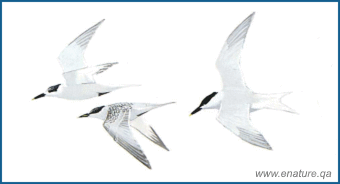
Sandwich Terns - an update.
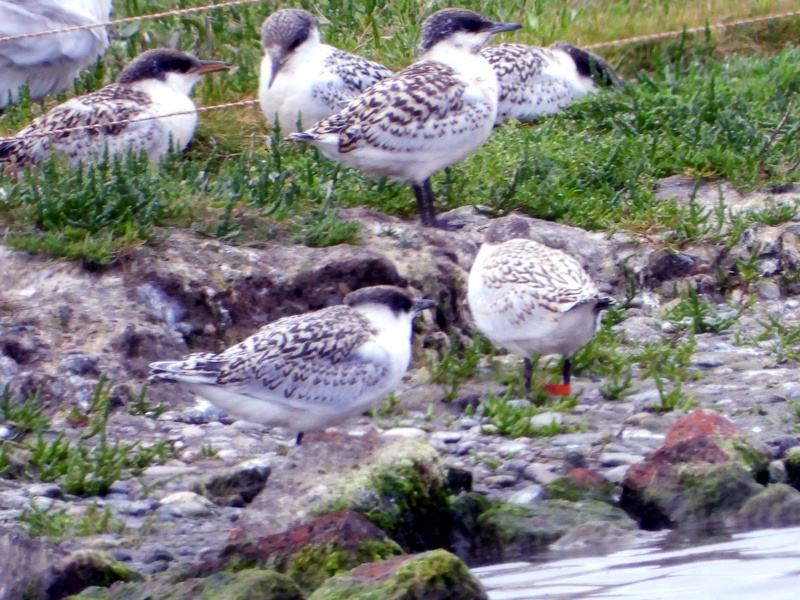
Tern chicks everywhere! What a wonderful sight
greeted me on my visit to Cemlyn Bay at the end of June last year.
After two horrendous years for seabirds, thanks to Bird Flu*, it was
just fantastic and heartwarming to see so many young birds. The totals
for 2024 at Cemlyn Bay were c2,000 Sandwich Tern chicks fledged from
2000 pairs, 200 Common Tern chicks fledged from 90 pairs and 400 Arctic
chicks
fledged from 210 pairs (Ref 1). To put those numbers into perspective
I'll go back to 2022 and give a brief summary of how Bird Flu has
affected Sandwich Terns over the past three years.
* Bird Flu is more correctly called highly pathogenic avian influenza (HPAI),
but it is commonly known as Bird Flu which is what I'll use in this
article.
Bird Flu
For the Sandwich Tern breeding colonies around the North Sea coasts 2022 was disastrous (Ref 2). The bird flu outbreak was centered in the Netherlands and some colonies there reported losses of 40 to 50% of adult birds. The disease spread to the east coast of England with colonies at Scolt Head and Coquet Island reporting losses of around 10%. The only colony in the Irish Sea which seems to have been affected that year was at Hodbarow (Cumbria), but this was late on in the season with only a few birds involved. Colonies around the Baltic Sea seem to have largely escaped it.
2023 saw the westward spread of the disease into the
Irish Sea. Both Hodbarrow and Cemlyn Bay saw birds dying of bird flu,
but the Sandwich Terns appeared to have built up some immunity and the
mortality rate was a lot lower than that in the Netherlands the
previous year. Remarkably, the Sandwich Tern colony near Wexford
(Lady's Lake) on the east coast of Ireland, and one of the largest
colonies in the British Isles, saw virtually no Bird Flu cases at all
(Ref 3).
At Cemlyn Bay around 1000 pairs of Sandwich Terns produced 400
fledglings, below averge numbers but still a reasonably good breeding
season.
So our Sandwich Terns in the Irish Sea seem to have
got off comparatively lightly in 2023, unfortunately the same thing
cannot be said of Common Terns. Both our local colonies, at Seaforth
and Shotton, suffered mass mortality of both adults and chicks.
Seaforth had around 50% mortality of adults whereas at Shotton, 75% of
adults disappeared, either dead or deserted (Ref 4). Other Common Tern
colonies, including those on the east coast of Ireland (Ref 3), had
similar losses.
It is going to take several years before we can properly assess the
impact of bird flu on terns and other sea birds, and many years for
them to recover - one auther (Ref 2) said it would take decades for
the Sandwich Terns in the Netherlands to return to previous numbers.
But, by all accounts, the recovery was well underway in 2024 with many
reports of a very good breeding season for terns. Common Terns
did well at Seaforth and Shotton, albeit with much lower numbers of
pairs than normal, but Sandwich Tern numbers both increased in terms of
pairs breeding and the number of young fledged. I've detailed numbers
above for Cemlyn Bay and I understand Hodbarrow also did well.
I've not mentioned Little Terns, that's because they
have been largely untouched by Bird Flu. This is probably because of
the lifestyle of these small terns, they don't normally mix with other
terns or, in particular, Black-headed Gulls which seem to have been a
major carrier of Bird Flu. Most importantly, the nests are spread out
much further than both Sandwich and Common Terns making infection
within breeding colonies much less likely (Ref 5).
We do know of one species which was very badly hit
by Bird flu, yet numbers made a rapid recovery. Over the winter of
2021/22 Bird Flu killed 11,400 Barnacle Geese which winter on the
Solway
Firth, about 31% of that population. Yet just two winters later
(2023/24), numbers were back to normal. I quote from Ref 6: "The large
impact of HPAI-related mortality on the Solway Barnacle Goose
population was rapidly recovered, probably through a combination of the
widespread development of natural immunity and high levels of breeding
success in the years following the outbreak."
Sandwich Tern Status
There's been quite a lot of work done on counting
Sandwich Terns in North-west Europe over the past few years,
both before and after the start of the Bird Flu outbreak. But, until a
clearer picture emerges of the effect of Bird Flu, there seems little
point in discussing their current status here. For further reading the
Sandwich Tern chapter in Ref 7 is well worth reading, as is Ref 8 which
is a summary of the affect of Bird Flu on seabirds in the UK.
Colour Rings
Given what's happened it becomes even more important
to monitor the Sandwich Terns, including reading colour rings. I start
this section with an extract from the Cemlyn Blog (Ref 1) from last
June which is an excellent description of the importance of colour
ringing:
June 20th 2024: There
are now hundreds of tern chicks on the islands. They are very mobile,
growing by the day and constantly hungry. We've seen lots of wing
flapping and stretching, but we're still a week or so off the oldest
ones taking flight for the first time. Yesterday 139 Sandwich Tern
chicks were given a metal leg ring and an orange flag, both with a
unique code to them. This is a really important source of data,
enabling us to know where our terns go after they leave us in July. It
helps us monitor population health and informs how best to help terns,
on a global scale, not just here at Cemlyn. And it means we know that
some come back to breed here after reaching maturity! Other tern
colonies have different colour ringing schemes, of which we've seen
many this year. Terns from all over the UK and Ireland, and the
Netherlands have all been seen here, showing that Cemlyn has a big
draw. This dataset is something that everyone can contribute to - by
looking out for and reporting any of our orange flagged birds when they
leave here at the end of the season. All ringing is done under licence
by experienced and skilled ringers.
The Liverpool Bay coast line is probably the most important area in the British Isles for post-breeding Sandwich Terns with up to 5,000 present between late June and the end of August. Quite a few can still be present through September and I was quite surprised to see 132 on a sand bank off New Brighton Promenade on the late date of Sep 25th last year. What the turnover of birds is over that period I have no idea, but the total numbers of Sandwich Terns passing through is going to be a lot more than 5,000.
Outside of the breeding colonies Liverpool Bay may
well be the most monitored area for colour ringed Sandwich Terns
throughout the range of this East Atlantic flyway population. I know
that there were over 400 records of colour rings along the North Wales
coast in 2024, with good numbers also recorded along the Sefton coast
between Seaforth and Ainsdale. Here, on the Dee Estuary, we only
managed a modest 66 records, but still an important contribution. It's
been a couple of years since I last wrote abour our Sandwich Tern
colour ringing activities (Ref 9) so below I summarise both the 2023
and 2024 seasons.
31 colour-ringed adults were recorded in 2023 but no chicks were ringed that year because of bird flu. In 2024 we saw 29 colour-ringed juveniles and 23 adults. The pie-chart shows were all these birds were ringed:
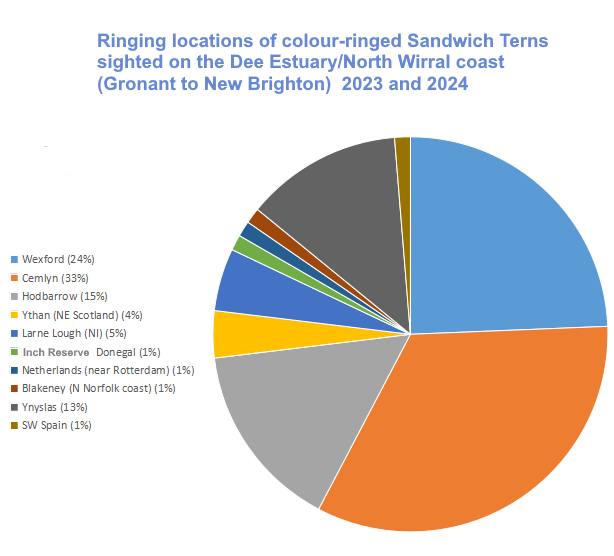
The map below shows the locations of these sites.
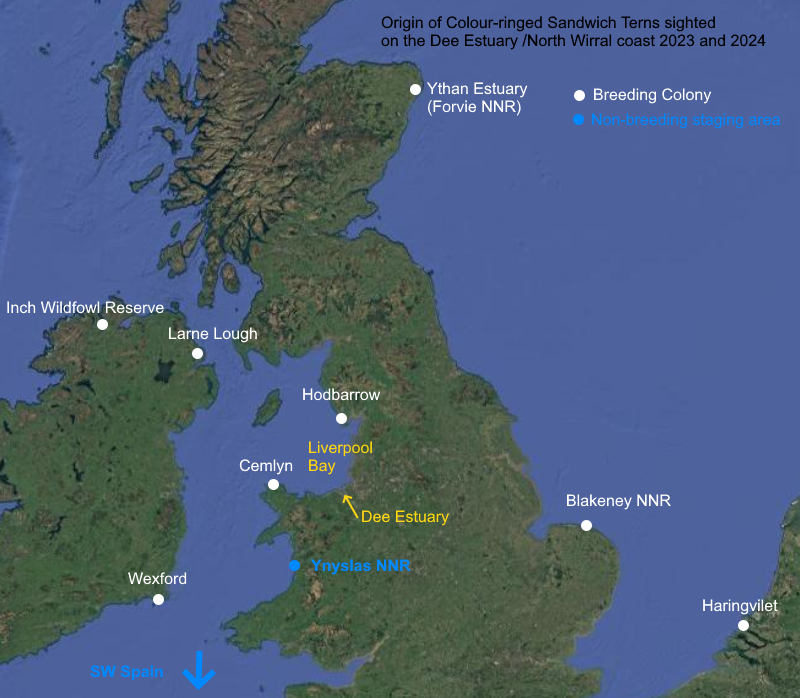
The three largest colonies in the Irish Sea provide
most of our colour-ring records - Cemlyn Bay, Hodbarrow and Wexford.
Although the large Lady's Island Lake colony at Wexford is quite a lot
further away from the Dee Estuary than the other two there is a well
documented post-breeding dispersal (discovered from colour ring
readings) into Liverpool Bay (Ref. 10) and we always see plenty from
there. The past two years saw our first records of birds ringed in the
county of Donegal, Larne Lough, Blakeney Point, Haringvilet
(Netherlands) and, excitingly, south-west Spain.
Movements
The movements of Sandwich Terns continue to fascinate and amaze me, and that's a huge motivation to go out colour ring spotting! When they are in Liverpool Bay in the summer there is constant movement and we get reports all along the coast with favourite sites being Rhos Point, Gronant, Hilbre, West Kirby and Formby, But sometimes they disperse more widely as demonstrated by this young bird:
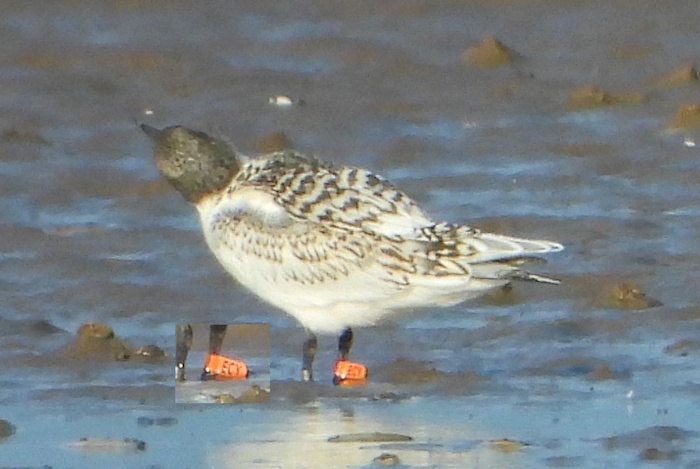
Orange ECY was fitted with a flag at Cemlyn Bay on June 19th 2024, one
of the 139 chicks ringed there that year. Like many others it flew with
its parents along the North Wales coast and was spotted at Hilbre on
July 15th and West Kirby on the 18th. Bearing in mind that all the
Sandwich Terns would be heading south-west within a few weeks of those
dates I find it remarkable that it was next seen on July 29th on the
Firth of Forth at Port Seton (a few miles east of Edingburgh) having,
presumably, flown north-east across the country from Liverpool Bay. It
then flew all the way back and was spotted at Rhos on Sea on September
11th. But this flying the 'wrong way' wasn't a one off oddity as five
more Sandwich Terns, which have also been seen on the Dee estuary, have
been recorded there in past years, as have two more juveniles with
orange flags from Cemlyn (both in 2022). There must be good feeding in
that part of the Firth of Forth to make it worthwhile flying all that
way and back.
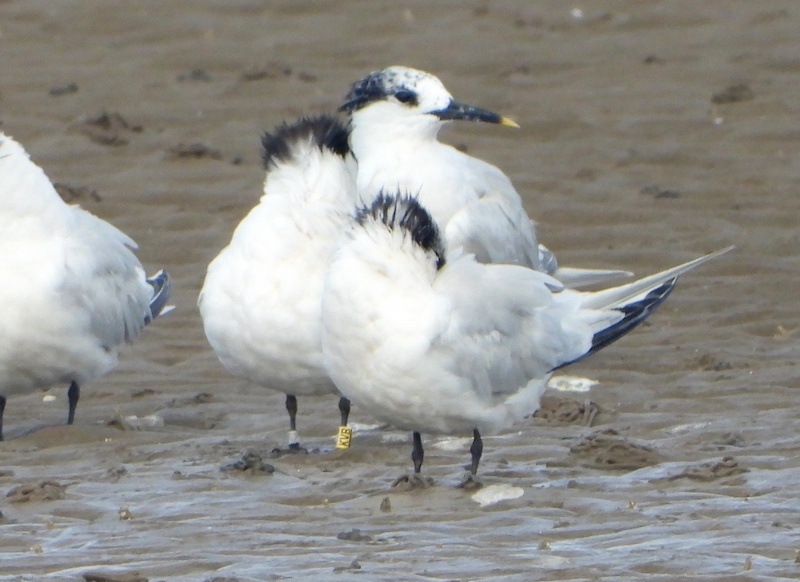
Yellow KVB was ringed as a chick at Wexford in June
2018. Most of these first year birds head south with the rest of the
population to spend the winter off the west coast of Africa. But this
one decided to head into the Mediterranean and was recorded off the
south coast of Italy in January 2019 - and that is the most easterly
European location where any of 'our' Sandwich Terns have been recorded.
It was at Hodbarrow in May 2022 (and probably bred there) and, in
August 2024, recorded at Hilbre and Formby.
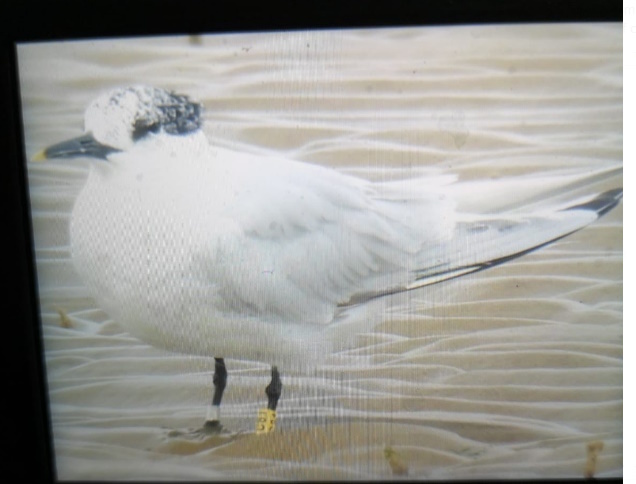
Yellow C81 was ringed as a chick in Hodbarrow in June 2022. Most of these young birds return to NW Europe when two years old (but usually don't breed) and this one was spotted on the northern tip of Denmark in early July 2024, our first record from that country. It returned to Liverpool Bay and we recorded it at Leasowe at the end of August that year. It will be interesting to see where it ends up breeding.
The Journey South
On their way south to spend the winter off Africa,
the birds we saw in 2023 and 2024 have been recorded on the south coast
of England and both the Portugese coast and south-west spain near
Cadiz. Reaching Africa we have a record from Agadir (Morocco) and three
from The Gambia. Gambia has a tradition of bird watching with a very
active Bird Observatory at Kartong as well as being a well known
destination for birders from Europe.
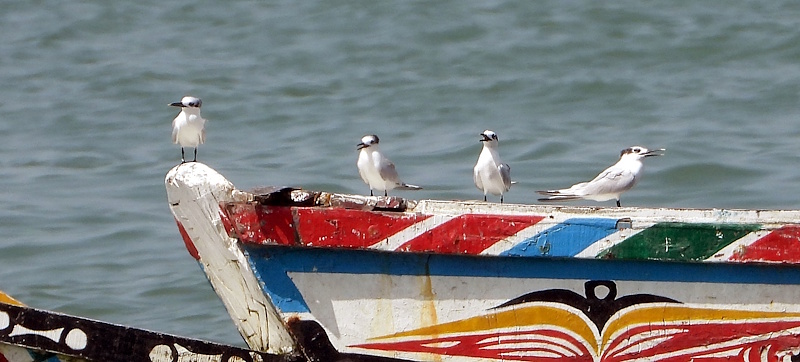
But then we have a big gap and the next records are way to the south,
at Namibia and then South Africa. Of the the 49 colour-ringed adults we
saw in 2023/24 a remarkable 13 have been seen in southern Africa, i.e.
just over a quarter. One of our birds, Orange C88, has been recorded at
Shearwater Bay, Namibia, a total of 17 times. Given that the chances of
any particular colour ringed bird being spotted is going to be a lot
less than 100% that implies a large proportion of Sandwich Terns travel
all the way to Namibia and/or South Africa each winter. Most records
from South Africa come from the beaches and bays close to Cape Town but
Green KOJ went all the way to Cape Recife just south of Gqeberha (which
used to be called Port Elizabeth) in January 2023, a straight line
distance from Liverpool Bay of 6,280 miles - whch must be our furthest
recovery of any ringed bird seen in our area. Wow!
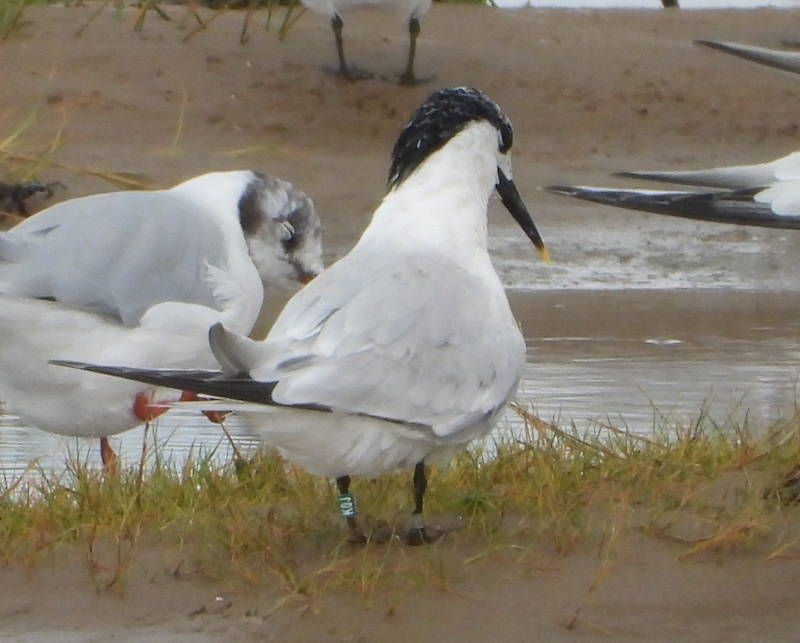
© Richard Smith
References
1. Discover
terns at Cemlyn (blog), North Wales Wildlife Trust.
2. Ulrich Knief et al., Highly pathogenic avian influenza causes mass mortality in Sandwich Tern Thalasseus sandvicensis breeding colonies across north-western Europe, Bird Conservation International, published on-line by Cambridge University Press in February 2024.
3. Brian Burke et al., A case study of the 2023
highly pathogenic avian influenza (HPAI) outbreak in tern (Sternidae)
colonies on the east coast of the Republic of Ireland, Bird Study 71,
2024.
4. Peter Coffey et al., Case study of the impact of an outbreak of high pathogenicity avian influenza (HPAI) on a seabird colony in Flintshire, Wales, United Kingdom, Bird Study - published on-line March 2025.
5. David norman et al., Near-absence of high pathogenicity avian influenza (HPAI) in Little Terns Sternula albifrons across 13 European countries, Bird Study 71, 2024.
6. Larry Griffin et al., Impacts of highly pathogenic avian influenza (HPAI) on a Barnacle Goose Branta leucopsis population wintering on the Solway Firth, UK, Bird Study 71, 2024.
7. David Burnell et al., Seabirds Count, Lynx Nature Books, 2023.
8. Constance J. et al., Declines in UK breeding populations of seabird species of conservation concern following the outbreak of high pathogenicity avian influenza (HPAI) in 2021–2022, Bird Study 71, 2024.
9. Richard Smith, Sandwich Terns and Colour Rings, July 2023 Newsletter
(Dee Estuary).
10. Tony Murray, Alyn Walsh & David Daly, Post-fledging dispersal of juvenile Sandwich Terns from Lady’s Island Lake, County Wexford, Ireland, Ringing & Migration, 2020 Vol. 35:1.
Richard SmithColour Ring Report
Orange Flagged Black-tailed Godwits

Over the winter of 2023/2024
twenty Black-tailed Godwits were each fitted with an orange flag at
Bangor Harbour (and adjacent sites) and since then they have shown some
interesting movements. It seems that the Black-tailed Godwits which
spend mid-winter between Anglesey and Aber Ogwen (including Bangor
Harbour), comprising of a few hundred birds, upsticks around
mid-February with most then flying to the Dee Estuary. A few fly to
other sites in north-west England as shown in the maps below, but they
stay in the area until the breeding birds fly off to Iceland, and then
return to north-west England in July. Again, they return almost
exclusively to the Dee Estuary where they moult into winter plumage.
Observations of the orange flags then suggest that around mid-October
they then all fly back to spend the winter again along the North Wales
coast.
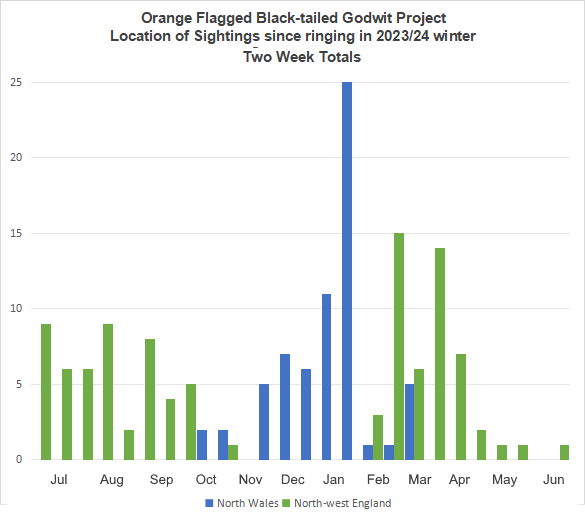
The bar chart above and the two maps below further illustrate this
movement. When the birds fly to the Dee Estuary they are joining
several thousand other Black-tailed Godwits and there was a record
count of 10,565 in August 2024. This movement of the 'Welsh' Godwits
was unknown before we were able to put flags on them. Interestingly,
colour-ringing has shown a similar movement of Knots which spend the
winter in the same general area of North Wales althouth their movement
east at the end of the winter seems to take place a bit later, around
late March and April, and many fly to the Sefton coast as well as the
Dee Estuary and north Wirral.

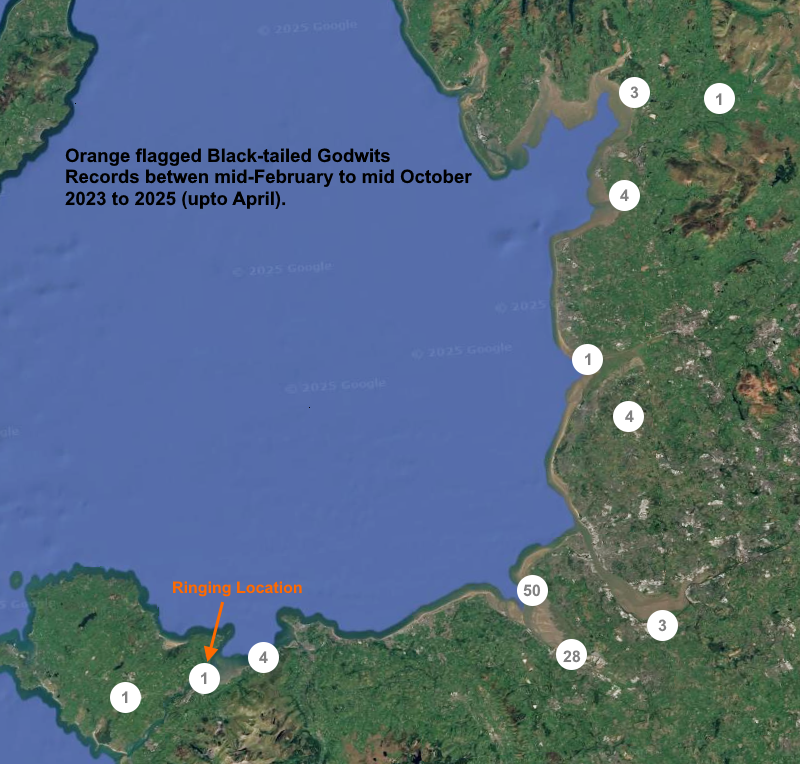
There have been a few records of these Orange flag
Godwits away from North Wales and North-west England as follows:
Oflag (AK) was at Hellifield Flash, North Yorkshire, in March 2024.
Oflag (AU) was at RSPB Saltholme on Teeside in April 2024 and on the
Stour Estuary, Suffolk, in August 2024.
Oflag (JN) was spotted in east Iceland in June 2024.
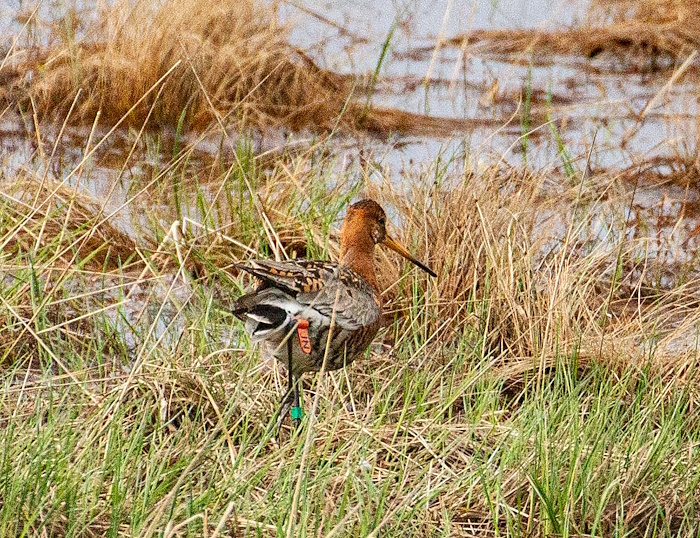
Many thanks to Stephen Dodd and the SCAN ringing group for providing
the data from the Orange flagged Black-tailed Godwit project.
Colour Rings were recorded by Richard
Smith, Stephen
Hinde, Colin Schofield, Alex Jones, Richard Speechley and David
Thompson.
Richard Smith
April Bird News
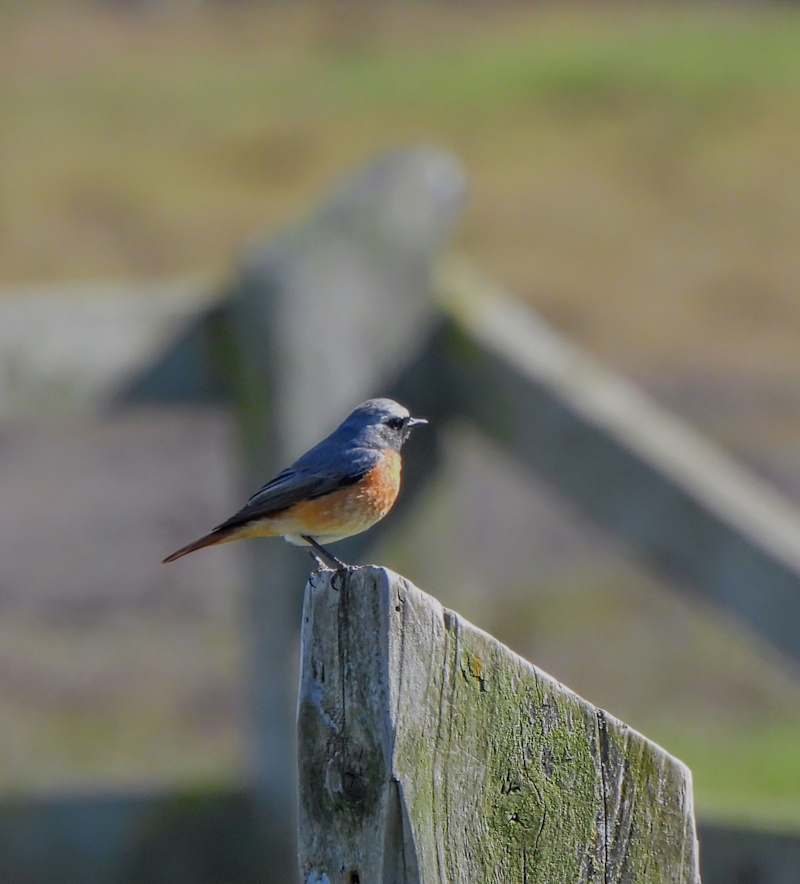
It was a relatively quiet spring passage this April but not without
interest, not least a report of a Moussier's Redstart at Leasowe. This
would have been only the second for the UK, so a real mega mega!
Unfortunately it was seen by only one person and the poor photo taken
was less than convincing. So, if it is submitted, it would seem to ne
unlikely to be accepted.
However, there were 22 Common Redstart records, which are always great to see. Just six Ring Ouzels was a disappointment, compared to last year's good total of 23. Yellow Wagtails just trickled through in ones and twos but it was good to record two Blue-headed Wagtails (near continent race of Yellow Wagtail) and a 'Channel' Wagtail (intermediate). The first Whinchat of the spring was seen at Gronant on the 12th, and they were then recorded almost daily with, typically, up to three present at Burton Point and around Leasowe Lighthouse. 11 Ospreys flew over, a fairly typical total and we would expect to see more in May.
The table below shows the first arrival of a
selection of spring migrants, with dates compared to the previous two
years. Birds arriving in March were fairly early given some good
weather, but overall these first dates are fairly typical.
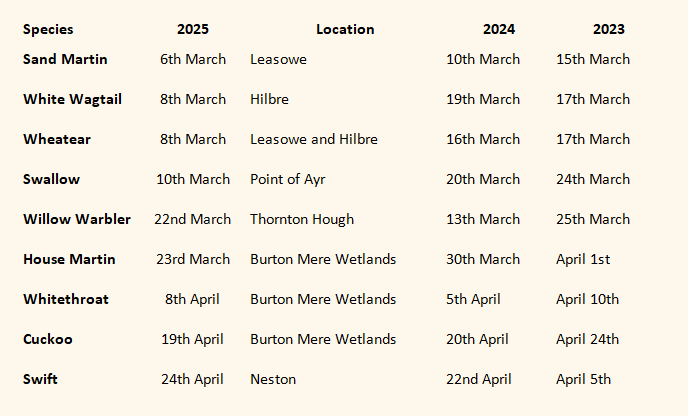

Moussier's Redstart beside, we did have some nice
rariries. A Great Grey Shrike showed well by Kerr's Field at Leasowe on
the 6th. There was a big influx of Hoopoes into the country in late
March and into April, with most on the south coast of Ireland, Wales
and England. We had hoped for a few here but they nearly all ended up
moving east, but right at the end of April one did turn up by
Greenfield Country Park and showed well for an hour or two.
On the 14th a White Stork flew over both Gronant and Hoylake, and one flew over Burton Mere Wetlands on the 28th. A Common Crane flew east over Ffynnongroyw on the 12th, probably the same one seen two days later on Shotwick Fields.
Given the problems Snadwich Terns have faced with Bird Flu (see above article) it was great to see 800 off Hilbre on the 20th, which we reckon is the largest number ever recorded here in April. 268 Gannets seen from Hilbre on the 25th was a good count.
The estuary always seems very empty in April with so
many waders having already left us, so it's always good to see the
arrival of the Whimbrels having flown directly from West Africa.
Numbers increased steadily and had reached at least 165 at Heswall and
34 at Hilbre by the 28th. Another species present in good numbers in
April are Black-tailed Godwits and 2350 at Caldy Wildfowl Collection on
the 7th is a record high spring count for that site (numbers are higher
in summer and autumn). On Good Friday Viv and I were in our hot tub
enjoying the sun when all 2,000 Black-tailed Godwits, by then in full
breeding plumage, flew over us at roof-top height on their way from
their Caldy roost site to feed at West Kirby. I would guess an
experience not many people have had!
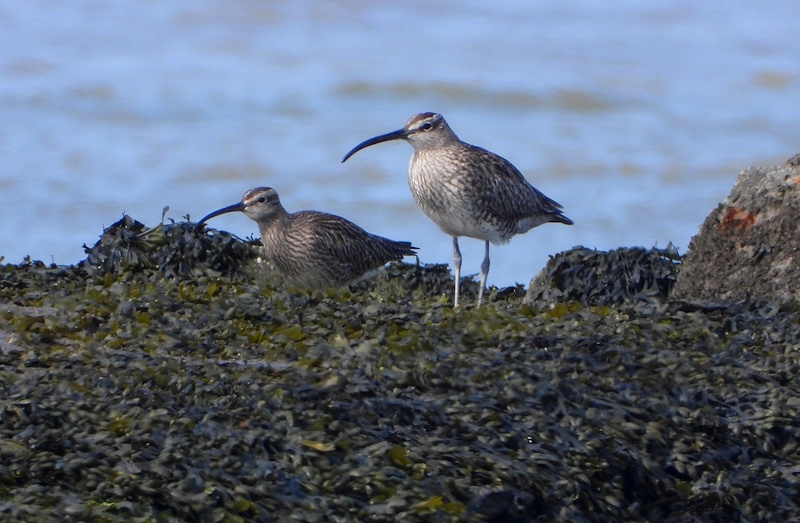
What to expect in May
Spring migration will still be in full flow in May. We will see our
first Spotted Flycatchers of the year and Whinchats will still be
coming through in good numbers. Wood Warblers are now quite rare but we
usually see one or two in May.
Perhaps surprisingly, we often see one or two Short-eared Owls this month, more often out at places like Gronant, Hilbre and Red Rocks rather than Burton Marsh where we see them in winter.
Whimbrels usually peak in the first week of May, I love to see them and hear there whistling calls along the stretch of shore between West Kirby and Heswall on a rising tide. The Dunlins which breed in Iceland will be passing through having spent the winter in West Africa. Look out also for Sanderlings and we often get one or two Curlew Sandpipers.
We often get Osprey sightings in May, with nesting well underway elsewhere any Ospreys seen this month are probably young birds prospecting for future nest sites.
May is usually good for rarities, in recent years we've had Puffins, Black-winged Stilt, Montagu's Harrier and Black Guillemot.
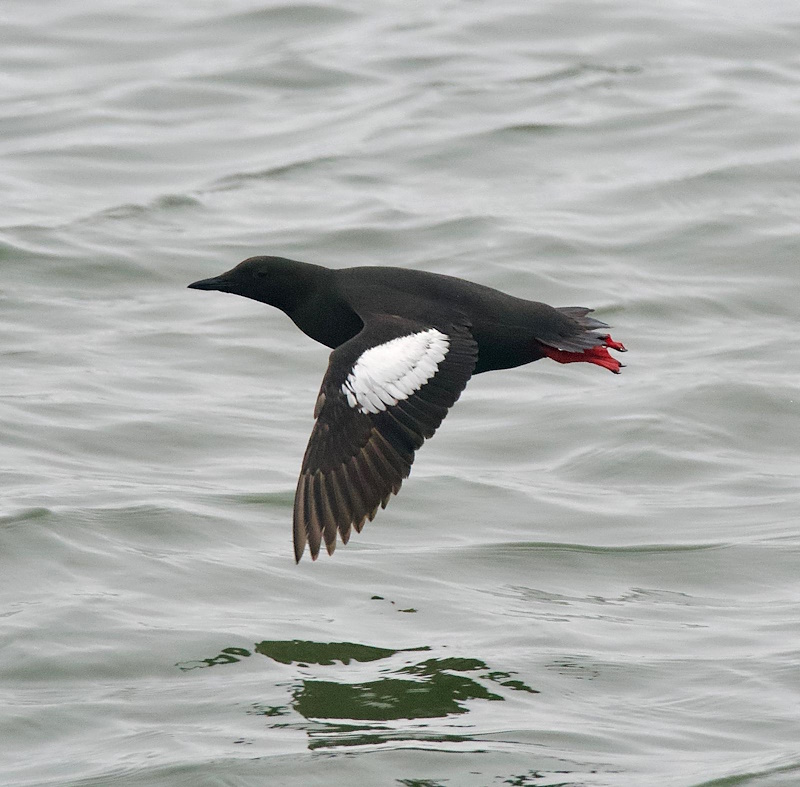
May Highest
Tides:
26th 1o.58hrs (BST) 9.5m
27th 11,48hrs (BST) 9.6m
28th 12.38hrs (BST) 9.5m